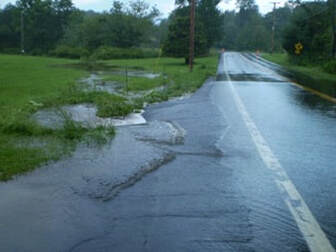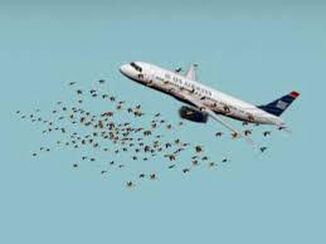 When it comes to Wildlife Hazard Management there may not be any greater double edge sword than Balancing Airport Stormwater and Management of wildlife. Airports are required to manage the quality of stormwater as well as ensure the safety of their day to day aircraft operations. This tends to increase the number of wildlife hazards and conflict with Federal, state, and local stormwater management regulations and guidelines. Why is this such an increasing or alarming problem? Due to the continuous loss of habitat and airports having to comply with requirements such as stormwater detention ponds which in many cases have exposed open water or vegetation that attract wildlife. This creates a predicament for air safety concerns! While on one hand airports are following guidelines and environmental standards it can serve as a beacon for wildlife. Airports are forced to balance increased growth and consumer demand while developing Wildlife Management tools to minimize public safety risk. Now What? With wildlife habitat being diminished daily in the United States (economic growth, population growth, etc.) the first step in airport safety as it pertains to wildlife hazards is to contact a Wildlife Management company to do an on-sight assessment to rate and scale how big of an issue your airport is facing. From there tools and practices can be implemented to ensure that not only are you following Federal, State, and Local stormwater regulations but to decrease your risk of aircraft safety. For more information on how to manage this problem please download this FREE E-Book or to schedule an on-sight assessment please fill out the fields below.
0 Comments
 The Goose population is increasing at an alarming rate. According to Ducks Unlimited Dr. Mark Petrie, North America has three times as many Geese as there were just 30 years ago, which offers many new challenges for management. See related article. Geese numbers can get so high that in an area, their droppings can cover your lawn, pollute your water, destroy a golf course, and increase risk for bird strikes on airfields. Obviously, the most common way to control the Goose population is depredation, whether it be by hunting, or oiling the nest in the spring. Let us look at the Top 5 Non-Lethal Techniques to Control Geese.
 Is your staff hindered by Guns and Ammo shortages? Are you noticing empty shelves at your chain retailer or local gun shop? Well do not worry you are not alone! For Loomacres Wildlife Management we cover just about every state in the lower 48 to provide airports and municipalities with their wildlife management needs. Our staff has had to rummage multiple stores in multiple cities to try and find the necessary ammo to keep up with our client’s needs. Sometimes we cannot resort to just trapping, and depredation is in order. Since Covid-19 hit the United States in March gun sales have been on the steady incline and has not stopped yet. The numbers in April, May and June are staggering with some states seeing a 400% jump in firearm sales. Some local gun store owners went from 10-20 customers a week to 20-30 an hour! But who cares about stats right? Where is the ammo and why can’t I buy any? This is America and when we want something, we want it now. Well here is a few contributing factors as to why ammo is so tough to buy right now since the C-19 Pandemic.
 Anytime a company is looking into outsourcing a part of their responsibilities, several factors come in to play. Some of the benefits to outsourcing is improving company focus, streamlining and increasing efficiency, as well as improving company focus just name a few. For many Airports around the United States, they are faced with a decision on whether to execute their Wildlife Hazard Management Plan internally or bring in the professionals like Loomacres Wildlife Management. Here are a few key factors you should consider when deciding to outsource your airports Wildlife Management. Reducing Operating Costs: Like most companies, airports, municipalities, and general people post Covid-19 pandemic budgets are tight. So, having a dedicated employee to your wildlife management could add either more man hours (or woman hours) to your annual payroll or create an entirely new position added to your payroll. Expertise: Anytime you outsource anything your goal is to bring in an expert. Companies like Loomacres Inc. have more on staff wildlife biologist than any other firm in the country. Each biologist specializes in different areas that can be applied to your Wildlife Hazard Management Plan. Simply put we do it better than you can. Mitigate Safety Risk: For containing or managing wildlife in your airport there a lot of hazards not just with wildlife but for your staff as well. Injuries, fatalities, and mistakes happen far too often when dealing with traps, firearms and pyrotechnics. By outsourcing to a private company, you can count on safety being at the top of the list on all projects. Training Costs: Each year the FAA requires a certain number of training hours and updated procedures when dealing with Wildlife Hazard Management Plans. By outsourcing this you are eliminating the risk of being out of compliance and drastically reducing any cost associated with training your staff. Most trainings are provided by the same company that you would be outsourcing to anyways. Accountability: Anytime you hire a vendor to complete a project or provide a service, a certain amount of accountability is brought to the table. When dealing with Wildlife Management companies you should be expecting a certain amount of professionalism, reliability, and ethics in order to assure your airport and aircraft safety is up to par! Basically, it is a lot easier to hold a vendor accountable especially one with on staff Biologist than one of your employees that you have invested money, time and effort training to do a task. When hiring an outside firm, you know they wont just walk off a job site creating an open position and a rehiring process. For more information download our FREE E-BOOK or contact us by filling out the fields below for an onsite assessment.  Wildlife collisions with aircrafts have occurred since the dawn of flying! Calbraith Rodgers who was the first man to successfully fly across the United States was also the first person to die as a result of bird strike to an aircraft. You decide which way he is remembered. The loss of revenue for costly repairs to aircrafts due to wildlife strikes is a global concern but the more important concern is passenger safety! When it comes to wildlife strikes no aircraft or airport is exempt. A Wildlife Hazard Assessment (WHA) makes it possible to gauge a species’ potential for a damaging collision with aircraft. By considering factors such as the body mass and density of the animal, its frequency on the airfield, the observed behaviors of the species, and its abundance and tendencies in the area, a prediction can be made concerning the risk species may pose on an airfield. The FAA is responsible for creating and enforcing the Federal Aviation Regulations (FAR) and policies to maintain public aviation safety. Compliance with FAR Part 139.337 (Appendix A), the FAA requires certified airports to conduct wildlife hazard assessment (WHA), and if necessary, establish a Wildlife Hazard Management Plan (WHMP) when the following events occur. 1. An aircraft experiences multiple bird strike or engine ingestion. 2. An aircraft experiences a damaging collision with wildlife other than birds. 3. Wildlife of a size or in numbers capable of causing an event described above is observed to have access to any airport flight pattern or movement area. So, what are some of the FAA approved methods to collecting Wildlife Hazard Assessment data? Loomacres Wildlife Management who was the first private sector company appointed by the FAA to service airports with their Wildlife Hazard Assessment and Wildlife Hazard Management Plans conduct the following methods to obtain data. Onsite Survey: These surveys are conducted at certain points in the airfield. What biologist are looking for is habitat that can hold or attract wildlife, species of wildlife such as small mammals, birds, fish and insects. All these surveys and discoveries are then recorded in an incident report. Biologist also look for potential holes in a fence line where animals from out of the airfield can come and go as they please increasing your risk. These surveys are done at different times (morning, afternoon, evening) to make sure all times of the day are covered. Offsite Surveys: The FAA requires that an offsite survey be conducted in a 5-mile radius surrounding your airport. What is taken into consideration here is attractants and habitat for animals to thrive in. Our biologist looks for bodies of water, habitat, food sources, and gathering points for migratory animals. All observations of species and how many species are then recorded in an incident report. These surveys are done at different times (morning, afternoon, evening) to make sure all times of the day are covered. Spotlight Survey: These are obviously done multiple times throughout the night but typically start ½ hour after sundown. The biologist will then drive around the perimeter of the airfield using a spotlight documenting nocturnal wildlife activity. Animals were viewed using a spotlight, their species, activity, location, and number were recorded. Small Mammal Trapping: Small mammals play a key role in the ecosystem and are a major prey species for foxes, coyotes, marten raptors, and other carnivores. By conducting a small mammal survey using traps in the airfield, biologist can identify the attractant for predators to lurk around the airport increasing the risk of an airstrike. Callback Survey: By using recorded sounds at different points on the airfield, biologist is looking and listening for responses made by owls, hawks, and other birds of prey. This will identify any species living on or near the airfield that can pose a potential airstrike risk. For more information please download this FREE E-BOOK or fill out the fields below and someone from Loomacres Wildlife Management will contact you. |
Sales & Marketing
|

 RSS Feed
RSS Feed